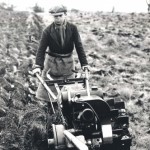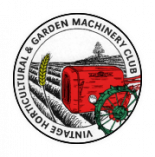Forum Replies Created
-
AuthorPosts
-
October 26, 2020 at 10:30 am #35686
 trusty220Keymaster
trusty220KeymasterThanks for your kind words again. Don’t forget, take your time because the results will last longer and give you more pleasure than if you rush the job and regret it afterwards.
October 22, 2020 at 6:26 pm #35642 trusty220Keymaster
trusty220KeymasterI’m glad that you see things our way- collectively we have a wealth of information that needs to be shared or recorded for future generations. That is why I wrote my two books on the Trusty so that my research doesn’t get forgotten when I’m gone; unfortunately we can’t all write books and this forum is the easiest way for people to put the information down, however trivial it may seem, so that it gives the future collectors some information that they otherwise wouldn’t be able to find.
One thing that hasn’t been mentioned is that the rotavator was sometimes referred to as a rotary hoe; I turned up some Trusty Earthquake literature that described it as a Rotary Hoe, with obvious legal implications from the rival firm of Rotary Hoes Ltd.
October 22, 2020 at 6:12 pm #35641 trusty220Keymaster
trusty220KeymasterNever give up, Alan. Don’t forget that I was looking for a Trusty Road Roller for twenty five years before I found one- it had been less than five miles from my home all the time!
On that basis, have you asked your neighbours?
October 22, 2020 at 6:09 pm #35640 trusty220Keymaster
trusty220KeymasterThanks for your kind comment, Charlie. I’m juggling this rebuild with work on the farm and rebuilding my trailer, that’s why there are large gaps inbetween stages. One day….
October 21, 2020 at 4:43 pm #35618 trusty220Keymaster
trusty220KeymasterRaining again today so a few hours in the garage.
I managed to buy some 1/2″ bright round bar from the steel stockist up the road and so I went over to see Johnny Polish; he has an oxy-propane set, so armed with my jig I hurried over to see him. Each one was warmed up to cherry red, inserted in the hole in the jig and bent through 90 degrees before the heat went out; a quick warm up again and the second part of the bend was completed by tapping with a hammer to get the complete 180 degree hook that I wanted.
Back home I cut a 1/2″ BSF thread on the other end and the hook was finished. If you study the old factory photo’s of the wheels you will see that there is also a special washer that goes under the nut to keep the other end of the hook bolt in contact with the rim. It has a flange on the top to stop it tipping and a hooked piece underneath which holds it in place under the outer rim.
Starting with a piece of angle I drilled a 1/2″ hole for the hook bolt to go through, then cut and hammered the rest of it into shape until it looked something like the original. It seems to work and you can judge for yourselves whether it looks right or not- I now know why the outer row of strakes wasn’t fitted when I bought it off Brian, because they are an absolute swine to get lined up and clamped down. I’ve left that for another day when I’ve got a fresh round of enthusiasm and my blood levels have recouped! Thinking about it, that’s probably why the wheels are painted red- so they don’t show the blood!
October 21, 2020 at 4:25 pm #35617 trusty220Keymaster
trusty220Keymaster……and mis-spelt!!
October 15, 2020 at 6:55 pm #35596 trusty220Keymaster
trusty220KeymasterOnly one with mine, Charlie. Yet again a good read, well done to you and Alan!
October 11, 2020 at 10:49 am #35577 trusty220Keymaster
trusty220KeymasterThanks for the advice. When you’ve got to spend £100 you need to be certain it will do the job. How is your Norton engine these days?
October 9, 2020 at 12:00 pm #35563 trusty220Keymaster
trusty220KeymasterThat would work but I’ve already bought a birthday present for Mrs. Geoff. Oh well, I could always buy her one for Christmas!
October 7, 2020 at 1:23 pm #35538 trusty220Keymaster
trusty220KeymasterThat’s the problem, Charlie. Looking at the old pictures it looks like they used 1/2″ round bar turned through 180 degrees to form a “J” and threaded (probably 1/2″ BSF) on the other end. A small curved washer was used to hold it to the outside so that the two rings were held between two hooks that could be bolted up tight.
I can get hold of the round bar but my problem at the moment is how to heat it to get it to bend without all my workshop stuff. The rest is pretty simple engineering that I can do with the tools I have in the garage; I wonder if the gas stove will get it hot enough? Better check the fire extinguishers first!
October 6, 2020 at 9:29 am #35519 trusty220Keymaster
trusty220KeymasterThe wheel has been progressing well so far and I have fitted the second segment to complete the inner ring of strakes; no drama whatsoever and you will see the finished item in the pictures.
One thing that normally gets missed off most Trusty restorations is the locking strips that prevent the wheel bolts from coming undone in use. With iron wheels the vibration is considerable and the bolts can shake loose quickly if not tightened on a regular basis and so the factory fitted two strips of metal to each wheel to keep the bolts tight. They are a simple thing to make: each strip is 3 1/2″ long by 1″ wide with two 1/2″ holes drilled 2 1/2″ apart. They fit under the head of the wheel bolt and the corner of the strip is turned upwards against one of the flats of the bolt head once the bolt is tightened. You get the idea from the pictures.
Years ago when they were new I don’t suppose much thought was given to protecting the paintwork when knocking these tabs over; I didn’t want to undo my good work, so I started by sticking a piece of masking tape alongside each tab. The masking tape will tear easily and so I used a patch of insulating tape over this to take the abrasion of the cold chisel; it did work but I think Duct Tape would have been stronger. Why didn’t I just stick that to the wheel and forget the masking tape? the glue they use on these tapes can lift the paint off and so I needed something a little less aggressive next to the paint.
You can judge for yourself the results.
Next job is to find some way of making the hook bolts to attach the outer ring. I don’t want to use roofing bolts because the thread is always metric and I want to keep this true to how it was made. Nobody said it was going to be easy!
October 4, 2020 at 6:46 pm #35507 trusty220Keymaster
trusty220KeymasterTry having a look at the story here from my Norton engine rebuild.
If you click on the link above you will find it takes you to my posting; to save looking through it all the carburettor jet is on page 4.
October 3, 2020 at 5:58 pm #35466 trusty220Keymaster
trusty220KeymasterHave a look at my thread from five years ago when I completely rebuilt a Norton Big 4 engine for a friend. It uses the same carburettor although it works the opposite way on the Howard but the jets will be the same.
Page 4 of “Trusty Steed Engine Rebuild” in the Projects section should be of some use; I’m assuming that the jet that you are having trouble with is the slow running mixture screw and I made a completely new one from scratch (and it worked!!).
Best of luck.
October 3, 2020 at 5:42 pm #35461 trusty220Keymaster
trusty220Keymaster“She Who Must Be Obeyed” helped me unload it after I bought it from the late Brian Carter, so I can’t hide it. At least she knows I’m not lying when I tell her,” Yes, I’ve had that for some time but it’s been at the back of the pile. You remember it, don’t you?”
Come on, admit it, how many of you have used that one before???
On to business- today has been wet and so I was confined to the garage again to carry on with the wheels. Searching for bolts I came across two very interesting ones; one had the name “BEES” and a drawing of a bee stamped in the head and the other had “SPARTS” stamped in. They have come from these wheels but apart from that I know nothing of their origin. Do any of you know which companies used these trade marks? Pictures below if you don’t believe me!
One segment is now fitted to the wheel disc and painted, the second half of the inner segment is on the bench with the first coat of red on it. Once they are both fitted there is a second row of strakes which fit to the outside of this but these are rivetted to a continuous strip that has been rolled into a circle; it is clamped to the first row with a series of hook bolts which I’m going to have to make somehow (I haven’t worked that one out yet).
September 28, 2020 at 2:59 pm #35435 trusty220Keymaster
trusty220KeymasterFarm work is starting to drop off a bit now so I can pick this thread up again. I went around to the shot blaster’s last week to pick up my wheels; he’d had them for nearly eighteen months but because I wasn’t pushing him for them he’d put them to one side. Not a problem, I was really looking for somewhere to put them when I emptied out my workshop at my parents’ old house and so long as they didn’t get thrown away I was quite happy to leave them there.
He’s done a good job on them. They are completely different to normal Trusty wheels in that they are bolted and riveted together with strakes that face backwards, the idea being that they come out of the ground vertically and leave the soil behind. They must have been very expensive to make which is probably why the welded wheels came along, but seeing as they are a feature of this tractor they have got to be right.
From the pictures you will see that I’ve finished one of the centres and bolted it to the tractor; the intention is to build the wheel up on the tractor so that I don’t get a hernia trying to manhandle it about whilst I paint it. I still have to find the correct wheel bolts to fix it permanently and I will also fit them with locking tabs as they used to make in the factory. These are simply 1″ wide strips of steel with a hole at either end for two wheel bolts; once the bolts are tightened the outside corners of the strips are turned upwards with a cold chisel and hammered onto the flats of the bolts to stop them coming loose. Just a small detail but just as important.
Here are the pictures. Yes, I know it’s covered in dust!
-
AuthorPosts




















